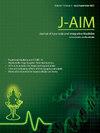Standardization of the traditional Pudam process in the manufacturing of Siddha medicine Anna Pavala Chendooram by using an innovative electrical device
IF 1.9
Q3 INTEGRATIVE & COMPLEMENTARY MEDICINE
引用次数: 0
Abstract
Background: The Siddha medicine system is one of the oldest traditional medicine systems and requires engineering equipment to reduce skill dependency for medicine manufacturing without compromising the efficacy of the medicine. Objective: The objective of the current work was to study the standard manufacturing method for a Siddha medicine anna pavala chendooram as per the conventional method and manufacture it in an electrical device designed for pudam process characterize it. Material and methods: Annabedhi (Ferrous sulfate) and kodipavalam (Coral) were taken as raw materials, anna pavala chendooram was prepared in the pit per conventional methods, and the same medicine was prepared in an electrical device for pudam; the prepared medicine from the pit and the device were characterized using modern scientific methods. Results: The maximum pressure built inside the sealed agal during the pudam was 35 mbar, and the maximum temperature during the pudam captured was 635 °C at the bottom. The XRD analysis reveals that the raw material consists of Fe2O3 (H2O)4, 2Fe (OH) SO4, and CaSO4 (H2O)4, and the finished medicine consists of Fe2O3 and CaSO4. The XRF analysis reveals that the major oxides in finished medicines were Fe2O3(T), SO3, CaO, and MgO. The average particle size of finished medicine from the pit is 6.52 μm, and the finished medicine from the device with seelaimann is 6.45 μm, and from the device without seelaimann is 6.28 μm. Conclusion: The pudam process for making anna pavala chendooram can be done using the device for pudam with the temperature profile obtained from the pit.
通过使用创新的电子设备,标准化了Siddha药物Anna Pavala Chendooram的传统Pudam工艺
背景:Siddha医学系统是最古老的传统医学系统之一,需要工程设备来减少药物制造对技能的依赖,而不影响药物的功效。目的:本研究的目的是在传统方法的基础上,研究西陀药阿那帕瓦拉的标准制备方法,并在为普旦工艺设计的电气装置中进行制备。材料和方法:以硫酸亚铁(Annabedhi)和珊瑚(kodipavalam)为原料,按常规方法在坑中制备anna pavala chendooram,在pudam的电装置中制备相同的药物;用现代科学方法对所制药物及装置进行了表征。结果:捕获过程中密封海藻内部的最大压力为35 mbar,捕获过程中底部的最高温度为635℃。XRD分析表明,原料由Fe2O3 (H2O)4、2Fe (OH) SO4和CaSO4 (H2O)4组成,成品由Fe2O3和CaSO4组成。XRF分析表明,制成品中主要的氧化物为Fe2O3(T)、SO3、CaO和MgO。从坑中得到的成品药平均粒径为6.52 μm,有seelaimann装置得到的成品药平均粒径为6.45 μm,无seelaimann装置得到的成品药平均粒径为6.28 μm。结论:利用该装置,利用坑内温度分布曲线,可完成anna pavala chendooram的pudam工艺。
本文章由计算机程序翻译,如有差异,请以英文原文为准。
求助全文
约1分钟内获得全文
求助全文
来源期刊

Journal of Ayurveda and Integrative Medicine
INTEGRATIVE & COMPLEMENTARY MEDICINE-
CiteScore
4.70
自引率
12.50%
发文量
136
审稿时长
30 weeks
 求助内容:
求助内容: 应助结果提醒方式:
应助结果提醒方式:


